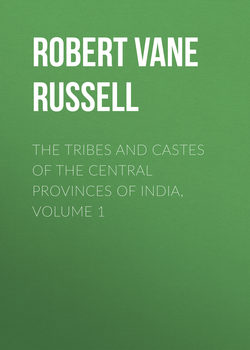Читать книгу The Tribes and Castes of the Central Provinces of India, Volume 1 - Robert Vane Russell - Страница 18
Part I.
Introductory Essay on Caste
Introductory Essay on Caste
15. Mixed unions of the four classes
ОглавлениеThe settlement of the Aryans in India was in villages and not in towns, and the Hindus have ever since remained a rural people. In 1911 less than a tenth of the population of India was urban, and nearly three-quarters of the total were directly supported by agriculture. Apparently, therefore, the basis or embryo of the gradation of Hindu society or the caste system should be sought in the village. Two main divisions of the village community may be recognised in the Vaishyas or cultivators and the Sūdras or impure serfs and labourers. The exact position held by the Kshatriyas and the constitution of their class are not quite clear, but there is no doubt that the Brāhmans and Kshatriyas formed the early aristocracy, ranking above the cultivators, and a few other castes have since attained to this position. From early times, as is shown by an ordinance of Manu, men of the higher castes or classes were permitted, after taking a woman of their own class for the first wife, to have second and subsequent wives from any of the classes beneath them. This custom appears to have been largely prevalent. No definite rule prescribed that the children of such unions should necessarily be illegitimate, and in many cases no doubt seems to exist that, if not they themselves, their descendants at any rate ultimately became full members of the caste of the first ancestor. According to Manu, if the child of a Brāhman by a Sūdra woman intermarried with Brāhmans and his descendants after him, their progeny in the seventh generation would become full Brāhmans; and the same was the case with the child of a Kshatriya or a Vaishya with a Sūdra woman. A commentator remarks that the descendants of a Brāhman by a Kshatriya woman could attain Brāhmanhood in the third generation, and those by a Vaishya woman in the fifth.40 Such children also could inherit. According to the Mahābhārata, if a Brāhman had four wives of different castes, the son by a Brāhman wife took four shares, that by a Kshatriya wife three, by a Vaishya wife two, and by a Sūdra wife one share.41 Manu gives a slightly different distribution, but also permits to the son by a Sūdra wife a share of the inheritance.42 Thus the fact is clear that the son of a Brāhman even by a Sūdra woman had a certain status of legitimacy in his father’s caste, as he could marry in it, and must therefore have been permitted to partake of the sacrificial food at marriage;43 and he could also inherit a small share of the property.
40
Hopkin’s and Burnett’s Code of Manu, x. 64, 65, and footnotes.
41
Mahābhārata, xiii. 2510 et. seq., quoted by Wilson, p. 272.
42
Manu, ix. 149, 157.
43
Manu indeed declares that such children could not be initiated (x. 68), but it is clear that they must, as a matter of fact, have been capable of initiation or they could not possibly have been married in the father’s caste.
